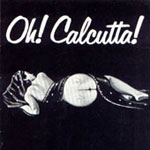
The fact that a single, human breath, devoid of any coherent meaning, can be freighted with so many interpretations has been a gift to many artists. Samuel Beckett took full advantage of this in his 1969 play Breath, the ‘dialogue’ of which consists of two cries book-ending an inhalation and exhalation. Most audiences confronted today with this half-minute gem presume that it’s a comment about the brevity and futility of human life. As he put it in Waiting for Godot: “They give birth astride a grave, the light gleams an instant and then it is night once more.” What they tend to forget is that Breath was originally conceived as a segment in Kenneth Tynan’s Oh! Calcutta!, a taboo-busting stage revue about, well, shagging.
But it’s pop music, of course, that has given most mileage to the notion that inarticulacy expresses far more than mere words. The whole genre of doo-wop is based on the idea, and many classic girl-group sides operate on the same basis: the idea that “doo-lang doo-lang” or “shoop-shoop” or “da-doo ron-ron” can encapsulate as much as the drollest Cole Porter couplet and then some. Sighs, sobs and gasps added to the dizzying drama.
It was a cover of a girl-pop classic, nearly 20 years after the genre’s heyday, that provided the apotheosis of the wordless gasp. Stiff Records now has a reputation for pub rock (the Brinsley Schwarz/Rockpile axis) and wry, vaudevillian pop (Ian Dury, Madness), but it was also home to some artists whose insane visions really shouldn’t have entitled them to chart placings. Stiff was the UK home of both Devo and Yello, and also made a point of offering refuge to idiosyncratic pre-punk refugees, including Larry Wallis and Dave Stewart.
The latter, a veteran of such Canterbury oddballs as Egg, Gong, Hatfield and the North and National Health, achieved his allotted quarter-hour in late 1981 with a cover of Lesley Gore’s ‘It’s My Party’, featuring vocals by his muse and paramour Barbara Gaskin. It maintains the original’s seemingly straightforward narrative, in which the nameless narrator has her birthday ruined by discovering that her boyfriend Johnny prefers the attentions of one Judy.
And yet there’s so much more. All the original girl-group classics were freighted with multiple layers of meaning, especially because they dealt with that most potent of phenomena, female sexuality. Thus, ‘Will You Love Me Tomorrow’ is really about losing one’s virginity; and ‘(You Make Me Feel Like) A Natural Woman’ is about a first orgasm. And don’t think that we’ve entirely got over the need for euphemism even today; check out Sugababes’ ‘Push The Button’.
Stewart adds to the ambiguity by dousing the production with quasi-psychedelic sound effects and a lurching, disoriented rhythm track that perfectly sums up the reality of teenage parties. The narrator (let’s call her Barbie) has clearly been at the Strongbow, and I strongly suspect somebody’s surreptitiously topped it up with something lysergic. There’s something deeply wrong going on here, and we don’t immediately know what it is. You can see Barbie, staggering around, banging into the stereo, haranguing her guests, treading dry-roasted cashews into the carpet, then locking herself in the toilet and sobbing.
The denouement comes about two-thirds of the way through:
“Judy and Johnny just walked through the door,
Like a queen with her king.
Oh, what a birthday surprise,
Judy’s wearing his ring.”
Of course, we’re back to veiled realities of girl-group discourse. In a Sandra Dee movie, maybe Judy really would be wearing Johnny’s ring, and his letterman jacket as well, and this would be enough to push Barbie over the edge. Face it, though, Barbie’s gone into the spare bedroom and found the underclad Johnny and Judy enjoying each other’s company in among the discarded coats. It’s not just his ring that she’s got hold of.
And so there’s The Gasp. At first, the listener presumes it’s Barbie who’s gasping, since she’s been the only voice so far. But listen harder. Could the gasp be another of the many sound effects, the gongs and bells and industrial clankings that soundtrack Barbie’s journey towards unhappy enlightenment? Is it really Barbie gasping, or could it be the wanton Judy? It sounds female, but we’ve already deduced that Barbie’s out of her gourd; so, taking on board her damaged perceptions, it could even be Johnny. If, maybe, it is Judy, is it a gasp of horror as she realises she’s been found out? Or a gasp of satisfaction as she enjoys Johnny’s manly attentions, unaware that Barbara’s seen them. Or both a partially stifled orgasmic yelp as she realises they’re being watched and simultaneously realises she likes it.
And, if it is Barbie who’s gasping, is it really a gasp of horror? Or something deeper and more animal, as her primal lust emerges when she sees the rutting couple? Shock and awe and a whole lot more. And which is the writhing body that provokes her lascivious gasp? Johnny or Judy? Some party.
It’s hard to believe now that an artefact of such quivering camp and addled ambiguity could top the UK charts, as it did in October, 1981. That single gasp offers fresh contexts to the whole narrative, in a way that mundane language could never offer. If anybody wants to restage Oh! Calcutta!, the complex troilism of Johnny, Judy and Barbie would make an excellent musical number. With the ghost of Samuel Beckett in among the coats.
© 2006 Tim Footman